Abstract
1. Contractions of flexor and extensor muscles of the knee and ankle were used to investigate presynaptic inhibition at the spinal level.
2. Contractions evoked dorsal root potentials, and increased the excitability of the central terminals of group Ia, Ib and low threshold cutaneous primary afferent fibres.
3. The monosynaptic reflexes recorded in response to stimulation of flexor or extensor muscle nerves were depressed, in the presence of strychnine hydrochloride 0·1 mg/kg I.V., by the contractions.
4. It is suggested that these presynaptic inhibitory effects are largely due to the activation of Golgi tendon organs by contraction.
Full text
PDF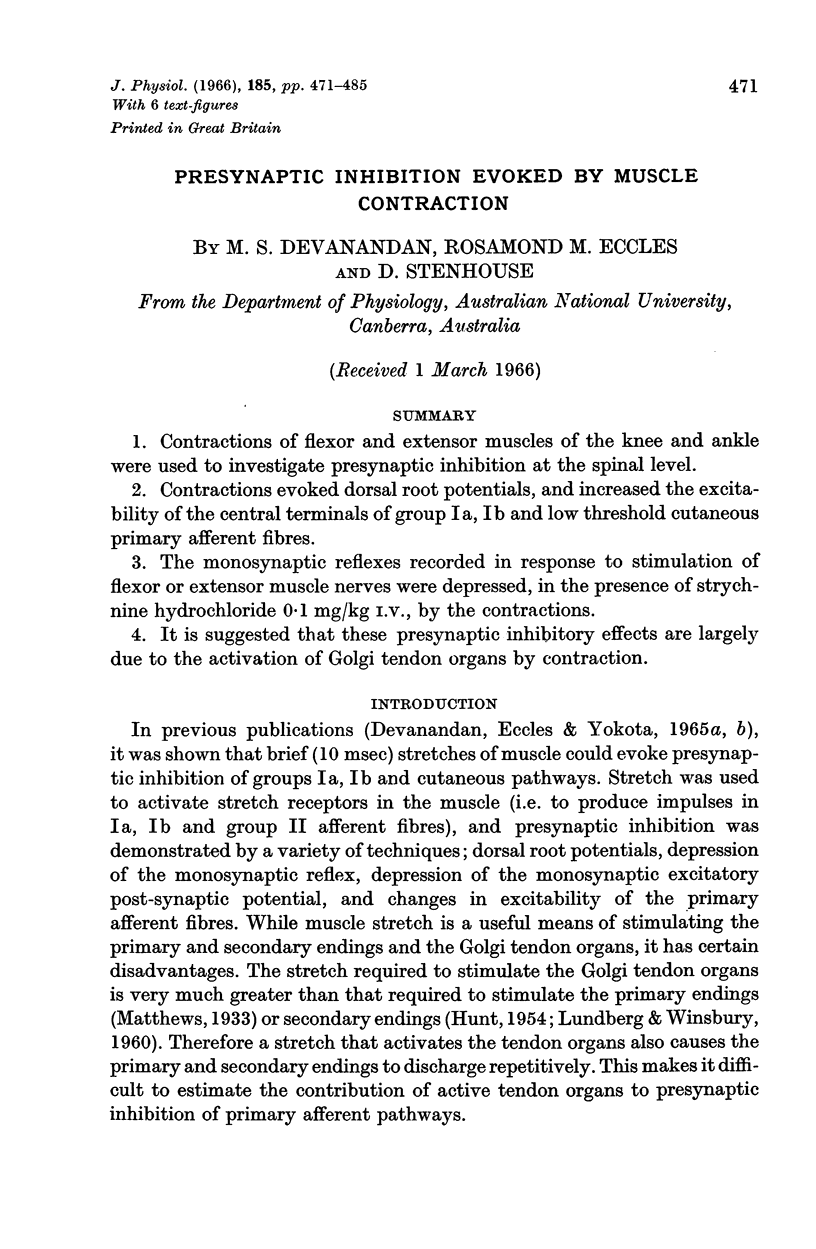
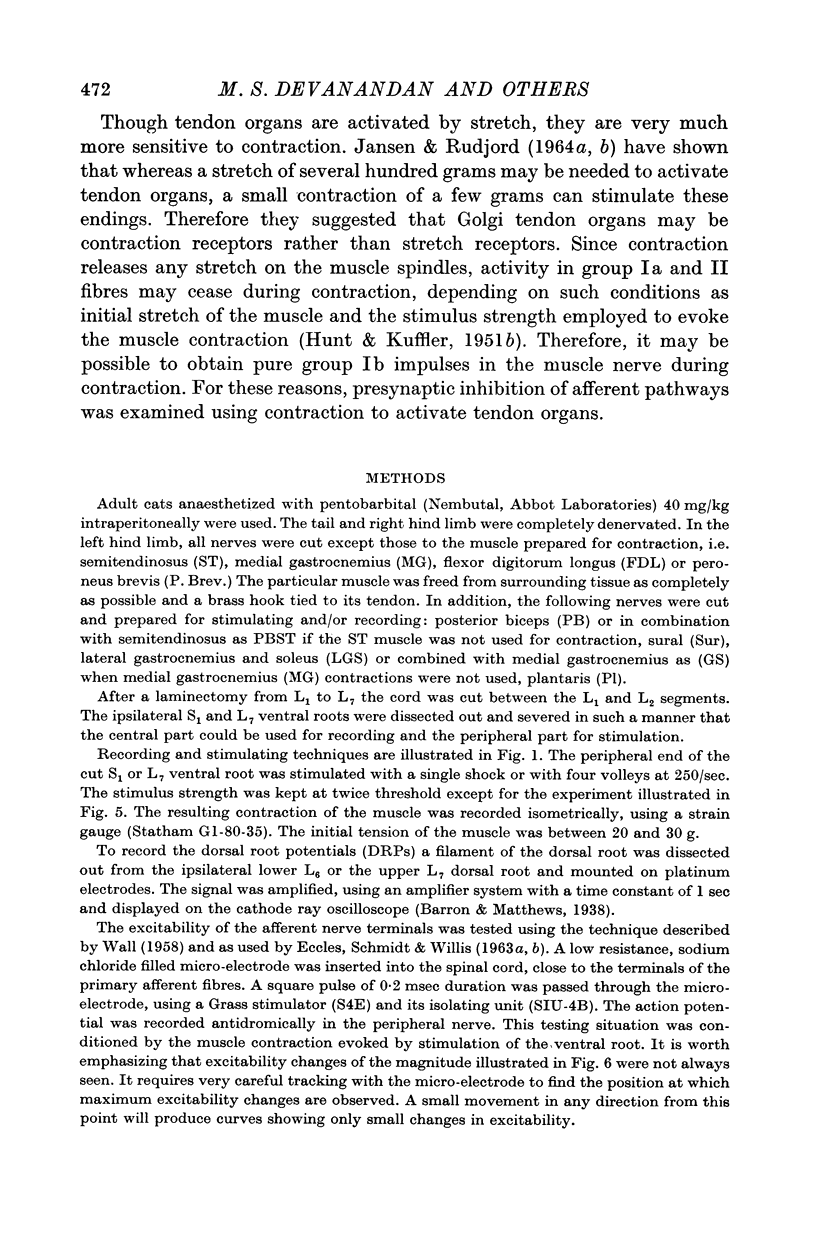
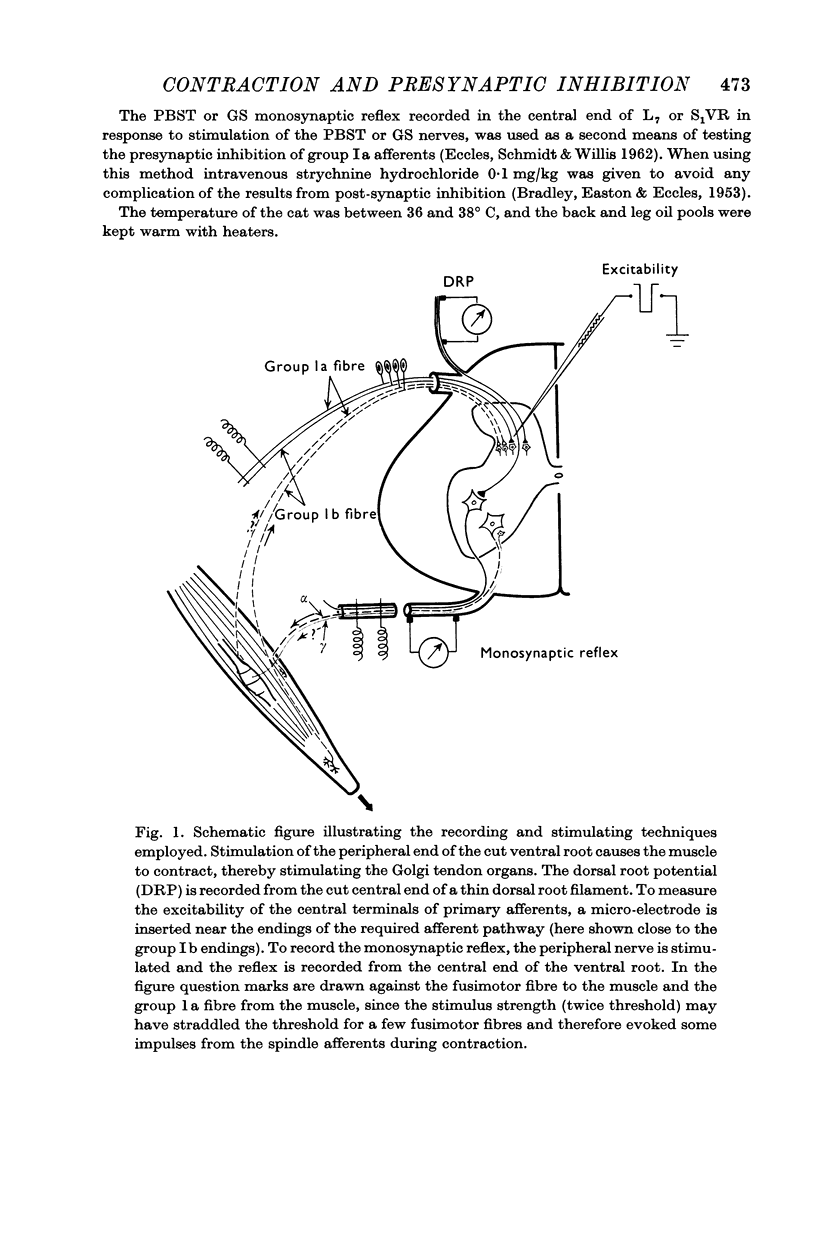
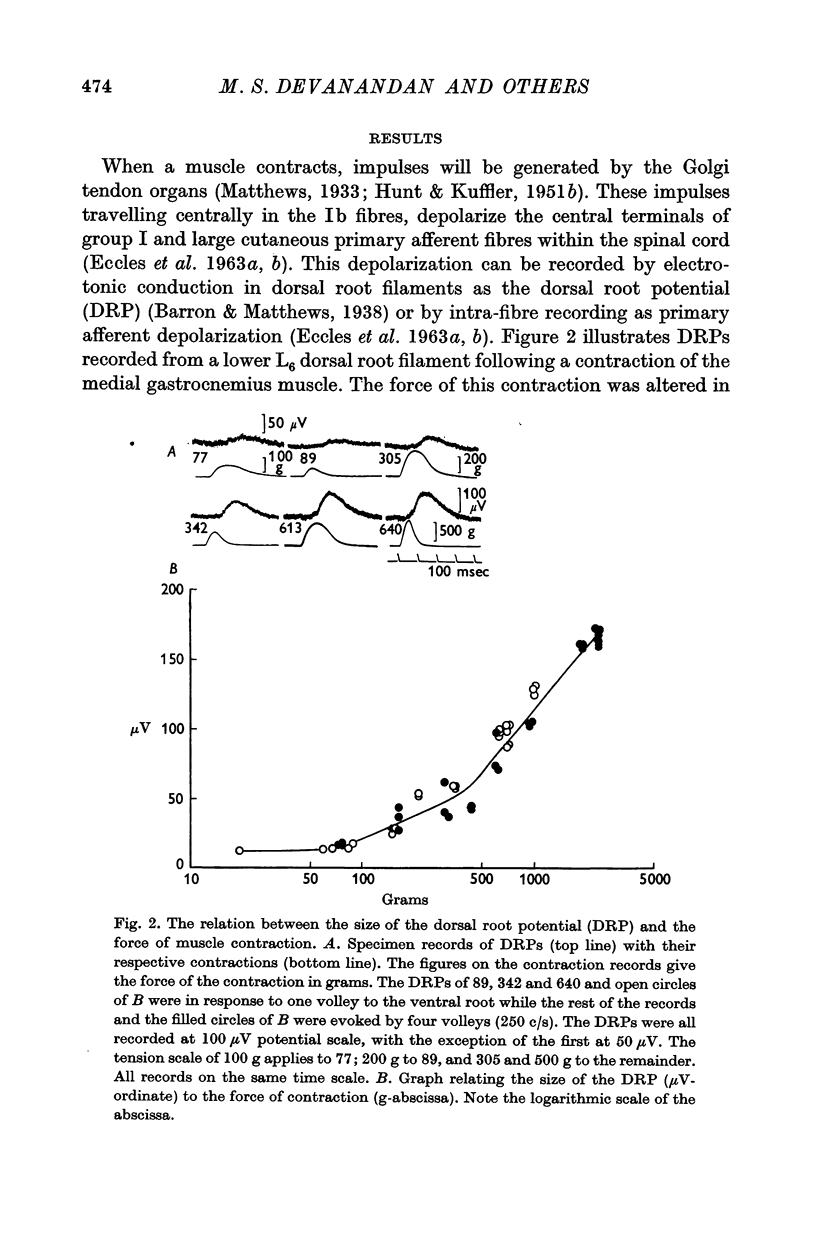
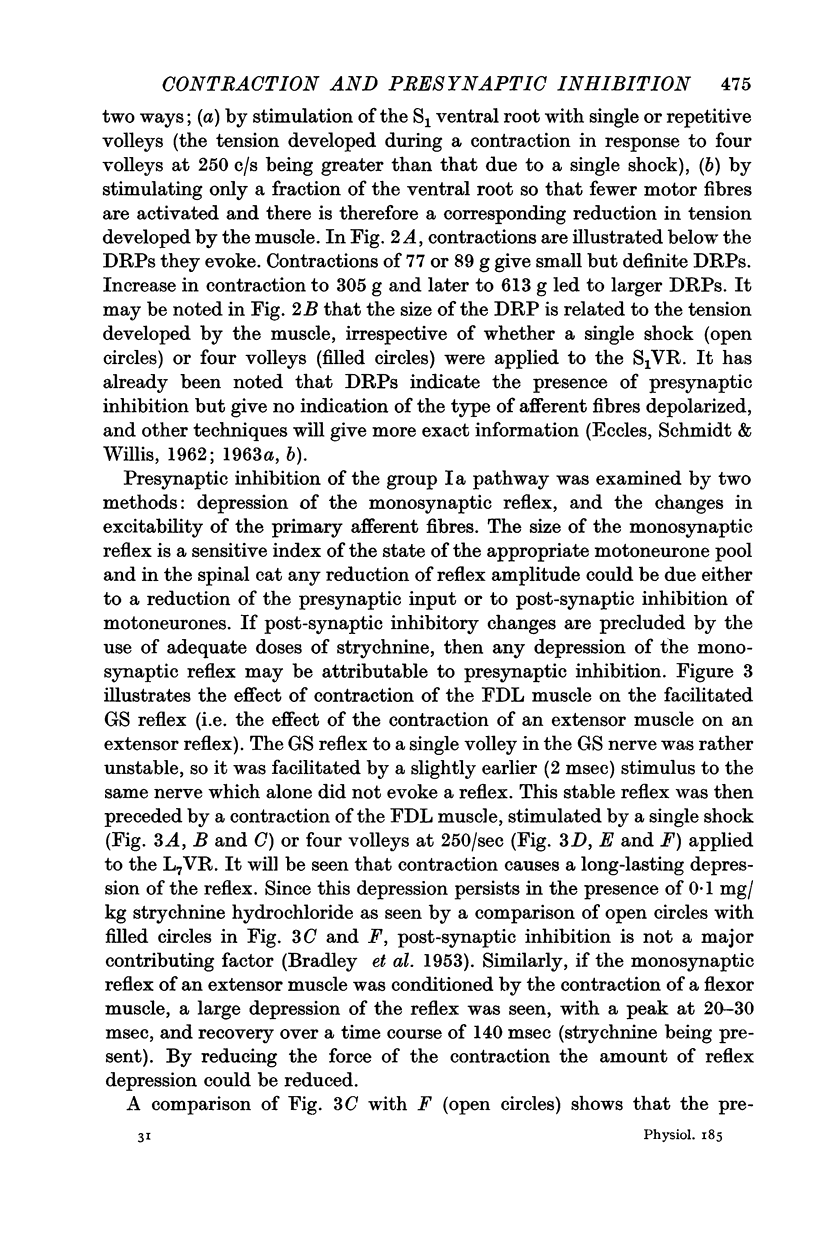
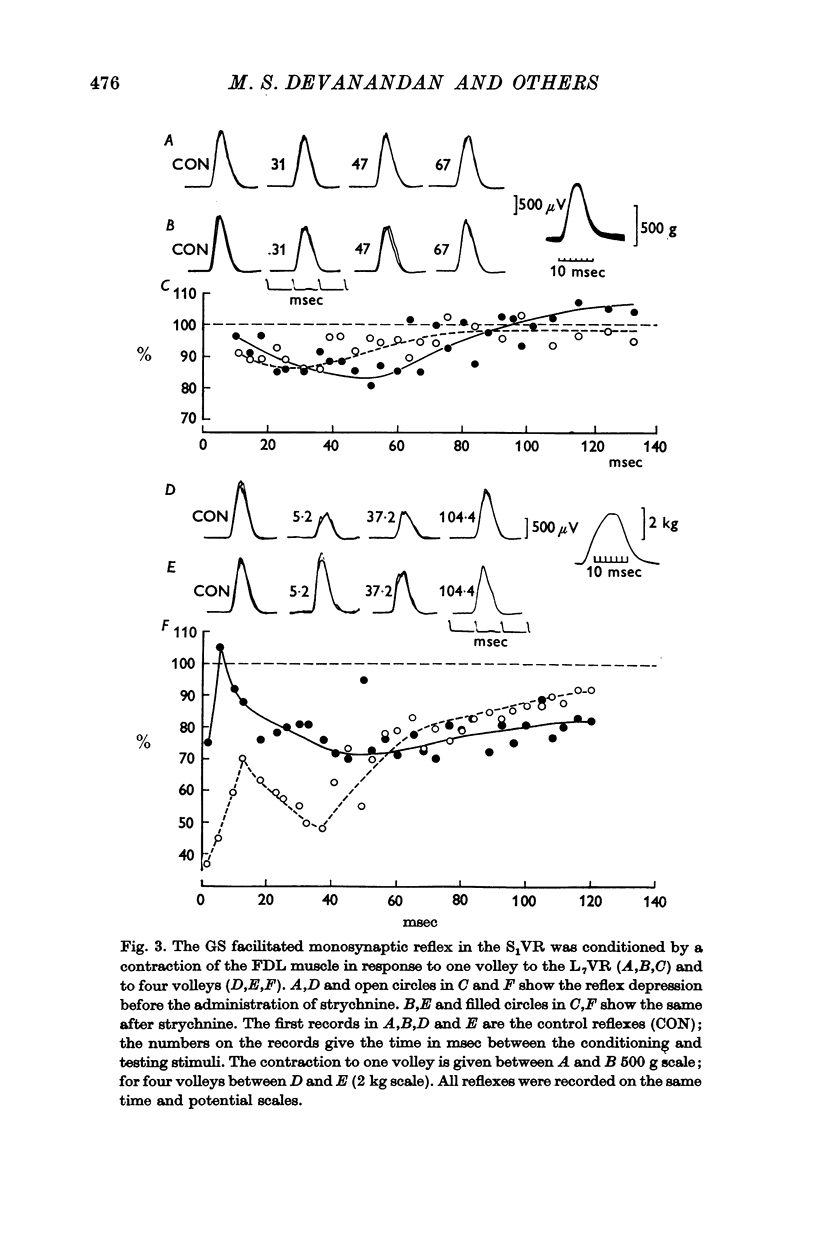
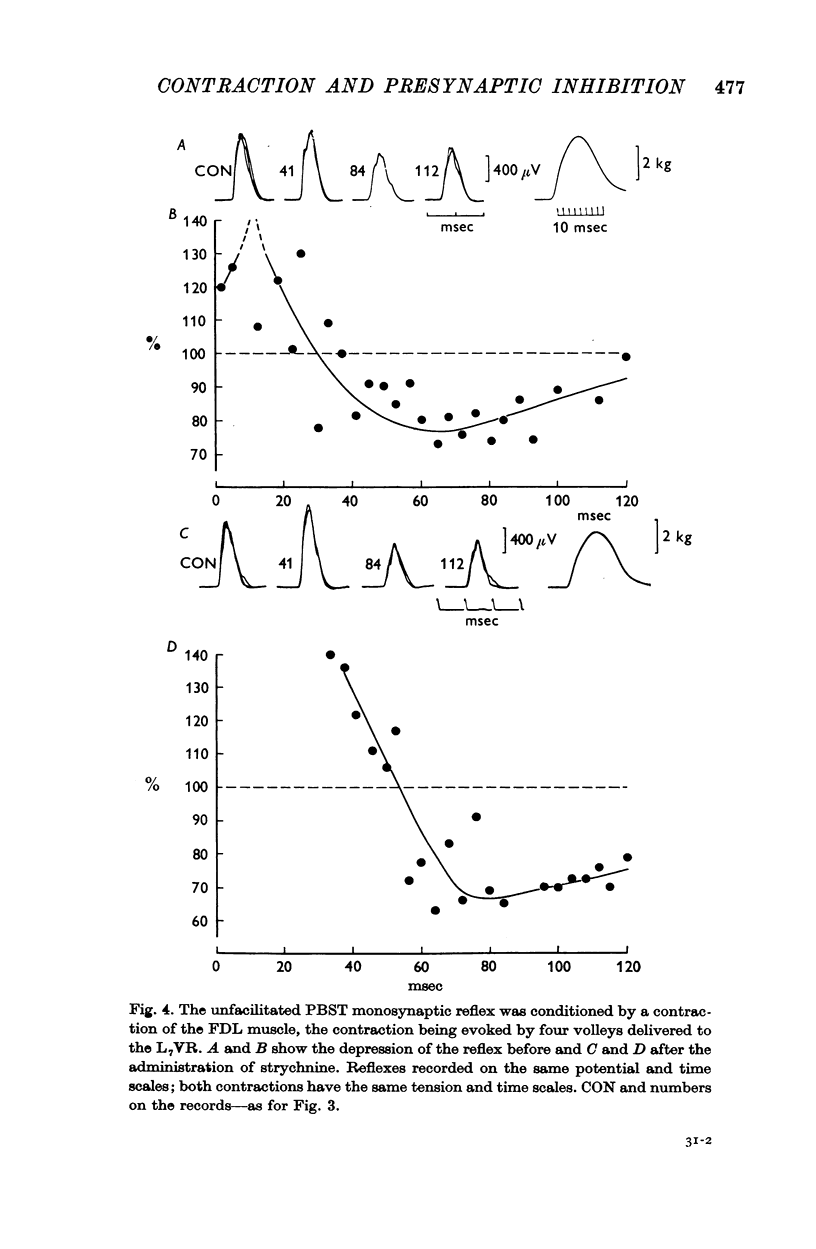




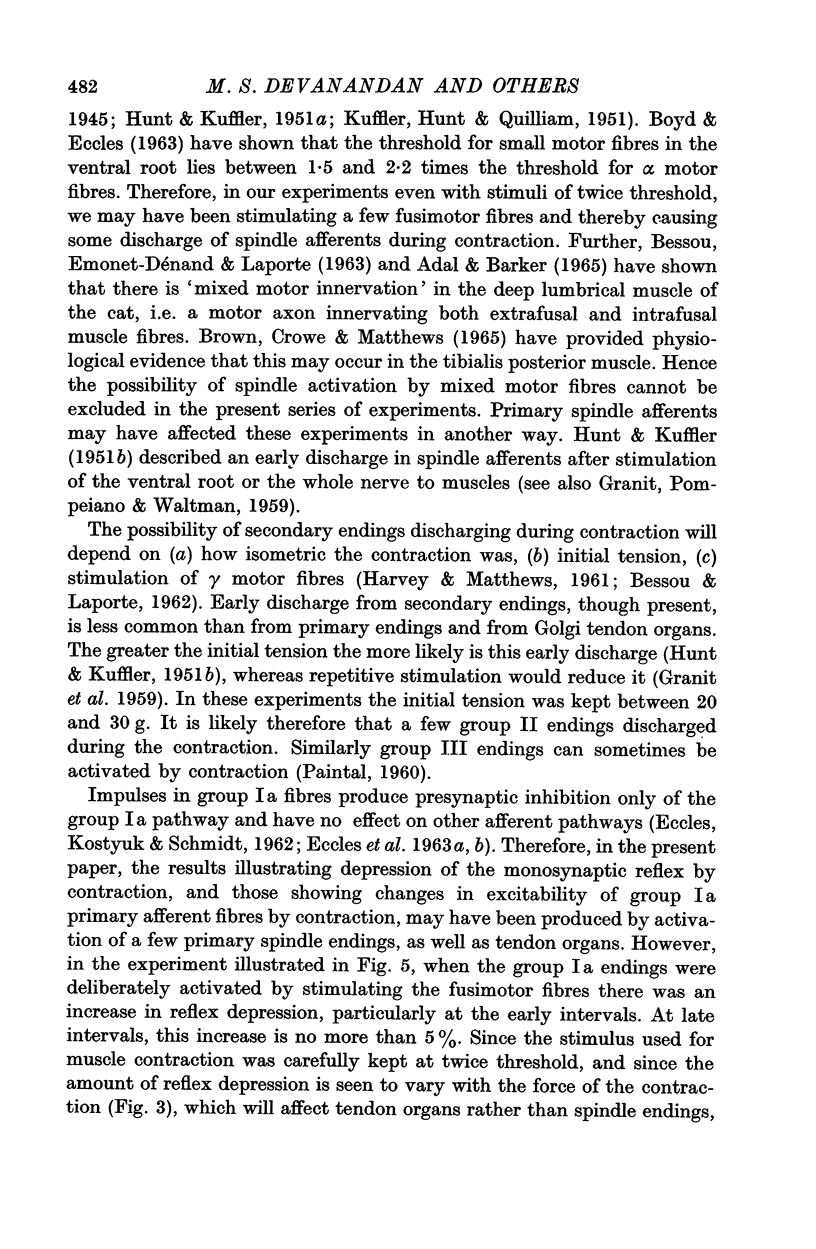
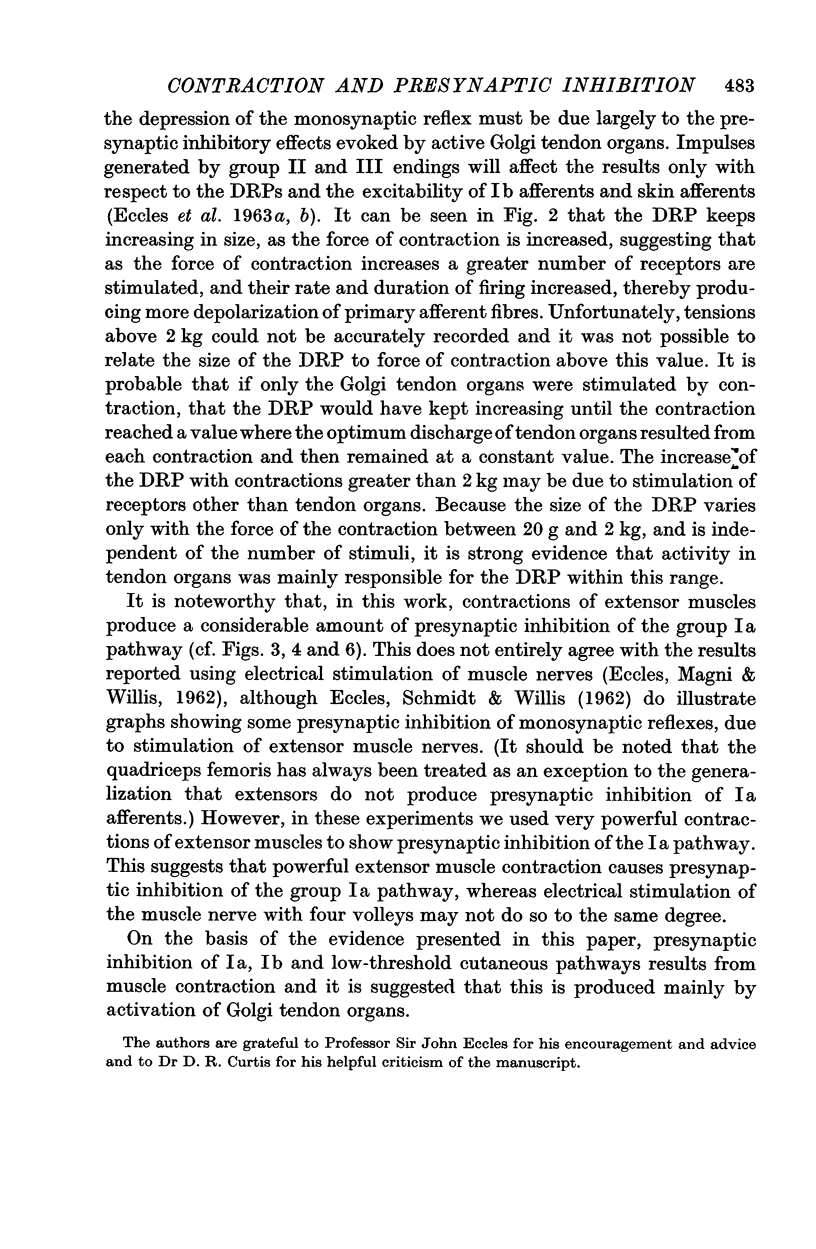
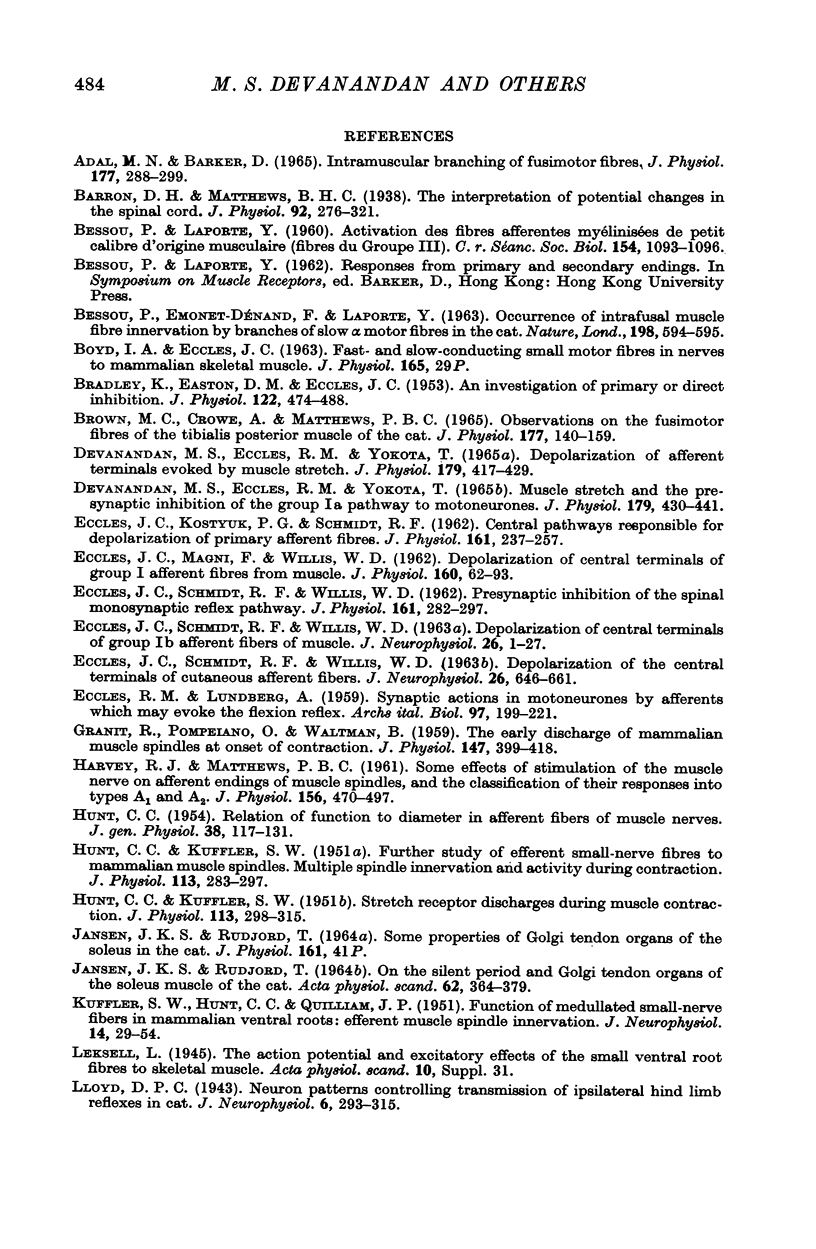
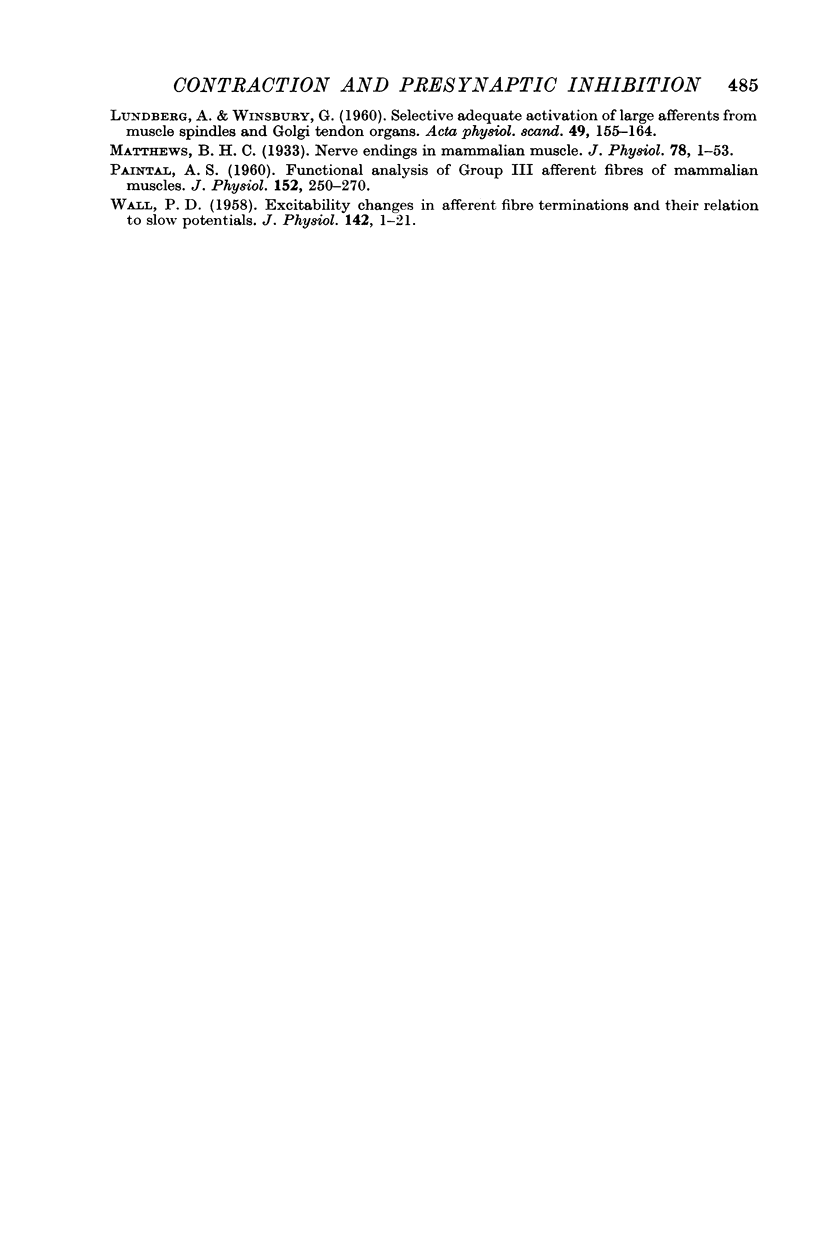
Selected References
These references are in PubMed. This may not be the complete list of references from this article.
- ADAL M. N., BARKER D. INTRAMUSCULAR BRANCHING OF FUSIMOTOR FIBRES. J Physiol. 1965 Mar;177:288–299. doi: 10.1113/jphysiol.1965.sp007592. [DOI] [PMC free article] [PubMed] [Google Scholar]
- BRADLEY K., EASTON D. M., ECCLES J. C. An investigation of primary or direct inhibition. J Physiol. 1953 Dec 29;122(3):474–488. doi: 10.1113/jphysiol.1953.sp005015. [DOI] [PMC free article] [PubMed] [Google Scholar]
- BROWN M. C., CROWE A., MATTHEWS P. B. OBSERVATIONS ON THE FUSIMOTOR FIBRES OF THE TIBIALIS POSTERIOR MUSCLE OF THE CAT. J Physiol. 1965 Mar;177:140–159. doi: 10.1113/jphysiol.1965.sp007582. [DOI] [PMC free article] [PubMed] [Google Scholar]
- Barron D. H., Matthews B. H. The interpretation of potential changes in the spinal cord. J Physiol. 1938 Apr 14;92(3):276–321. doi: 10.1113/jphysiol.1938.sp003603. [DOI] [PMC free article] [PubMed] [Google Scholar]
- Devanandan M. S., Eccles R. M., Yokota T. Depolarization of afferent terminals evoked by muscle stretch. J Physiol. 1965 Aug;179(3):417–429. doi: 10.1113/jphysiol.1965.sp007670. [DOI] [PMC free article] [PubMed] [Google Scholar]
- Devanandan M. S., Eccles R. M., Yokota T. Muscle stretch and the presynaptic inhibition of the group Ia pathway to motoneurones. J Physiol. 1965 Aug;179(3):430–441. doi: 10.1113/jphysiol.1965.sp007671. [DOI] [PMC free article] [PubMed] [Google Scholar]
- ECCLES J. C., KOSTYUK P. G., SCHMIDT R. F. Central pathways responsible for depolarization of primary afferent fibres. J Physiol. 1962 May;161:237–257. doi: 10.1113/jphysiol.1962.sp006884. [DOI] [PMC free article] [PubMed] [Google Scholar]
- ECCLES J. C., SCHMIDT R. F., WILLIS W. D. Presynaptic inhibition of the spinal monosynaptic reflex pathway. J Physiol. 1962 May;161:282–297. doi: 10.1113/jphysiol.1962.sp006886. [DOI] [PMC free article] [PubMed] [Google Scholar]
- Eccles J. C., Magni F., Willis W. D. Depolarization of central terminals of Group I afferent fibres from muscle. J Physiol. 1962 Jan;160(1):62–93. doi: 10.1113/jphysiol.1962.sp006835. [DOI] [PMC free article] [PubMed] [Google Scholar]
- GRANIT R., POMPEIANO O., WALTMAN B. The early discharge of mammalian muscle spindles at onset of contraction. J Physiol. 1959 Sep 2;147:399–418. doi: 10.1113/jphysiol.1959.sp006251. [DOI] [PMC free article] [PubMed] [Google Scholar]
- HARVEY R. J., MATTHEWS P. B. Some effects of stimulation of the muscle nerve on afferent endings of muscle spindles, and the classification of their responses into types A1 and A2. J Physiol. 1961 May;156:470–497. doi: 10.1113/jphysiol.1961.sp006688. [DOI] [PMC free article] [PubMed] [Google Scholar]
- HUNT C. C., KUFFLER S. W. Further study of efferent small-nerve fibers to mammalian muscle spindles; multiple spindle innervation and activity during contraction. J Physiol. 1951 Apr;113(2-3):283–297. doi: 10.1113/jphysiol.1951.sp004572. [DOI] [PMC free article] [PubMed] [Google Scholar]
- HUNT C. C., KUFFLER S. W. Stretch receptor discharges during muscle contraction. J Physiol. 1951 Apr;113(2-3):298–315. doi: 10.1113/jphysiol.1951.sp004573. [DOI] [PMC free article] [PubMed] [Google Scholar]
- HUNT C. C. Relation of function to diameter in afferent fibers of muscle nerves. J Gen Physiol. 1954 Sep 20;38(1):117–131. doi: 10.1085/jgp.38.1.117. [DOI] [PMC free article] [PubMed] [Google Scholar]
- JANSEN J. K., RUDJORD T. ON THE SILENT PERIOD AND GOLGI TENDON ORGANS OF THE SOLEUS MUSCLE OF THE CAT. Acta Physiol Scand. 1964 Dec;62:364–379. doi: 10.1111/j.1748-1716.1964.tb10435.x. [DOI] [PubMed] [Google Scholar]
- KUFFLER S. W., HUNT C. C., QUILLIAM J. P. Function of medullated small-nerve fibers in mammalian ventral roots; efferent muscle spindle innervation. J Neurophysiol. 1951 Jan;14(1):29–54. doi: 10.1152/jn.1951.14.1.29. [DOI] [PubMed] [Google Scholar]
- LUNDBERG A., WINSBURY G. Selective adequate activation of large afferents from muscle spindles and Golgi tendon organs. Acta Physiol Scand. 1960 Jul 15;49:155–164. doi: 10.1111/j.1748-1716.1960.tb01939.x. [DOI] [PubMed] [Google Scholar]
- Matthews B. H. Nerve endings in mammalian muscle. J Physiol. 1933 Apr 13;78(1):1–53. doi: 10.1113/jphysiol.1933.sp002984. [DOI] [PMC free article] [PubMed] [Google Scholar]
- PAINTAL A. S. Functional analysis of group III afferent fibres of mammalian muscles. J Physiol. 1960 Jul;152:250–270. doi: 10.1113/jphysiol.1960.sp006486. [DOI] [PMC free article] [PubMed] [Google Scholar]
- WALL P. D. Excitability changes in afferent fibre terminations and their relation to slow potentials. J Physiol. 1958 Jun 18;142(1):1–21. doi: 10.1113/jphysiol.1958.sp005997. [DOI] [PMC free article] [PubMed] [Google Scholar]


